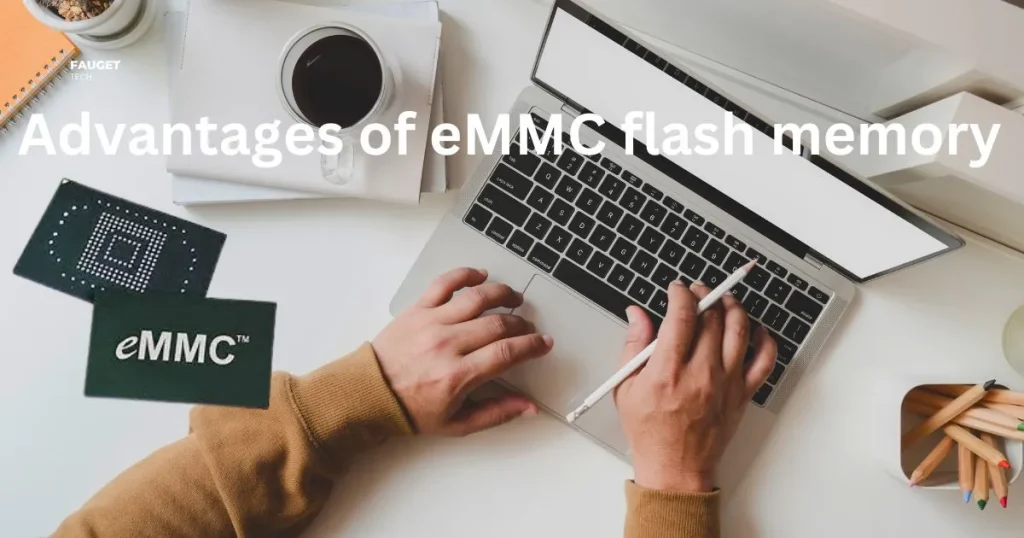The term ‘eMMC’ stands for Embedded MultiMediaCard, which is flash memory designed to be used with devices such as mobile phones and tablets.
On a Chromebook, eMMC is the main type of storage medium and it consists of NAND chips, which are similar to RAM but can store data even when powered off.
It offers faster performance than regular hard drives as well as smaller form factor, greater capacity and improved reliability compared to traditional spinning disk drives.
History and Role of eMMC Flash Memory on a Chromebook
Since its introduction in 2010, the use of integrated flash memory on laptops has grown steadily over the years. It was due to the increasing demand for high-speed computing and storage, as well as its portability and low power consumption.
In 2012, Google introduced Chromebooks which ran on the Chrome OS operating system.
These devices were designed to be lightweight and inexpensive laptops that could provide an efficient way to access web applications and data stored in the cloud.
eMMC Flash memory was an ideal choice for these machines due to its faster performance, smaller size and lower power usage. It is now used by most Chromebooks on the market today.
Advantages of using eMMC flash memory in Chromebooks:
1- Faster performance and increased storage capacity
One of the main advantages of using flash memory in Chromebooks is its ability to provide faster performance and increased storage capacity.
It allows users to open applications quickly and access large files without experiencing any lag or slowdown in their device’s performance.

It also offers more space to store data, which makes it simpler for users to save documents, photos and other types of media on their device.
2- Lower power consumption and heat dissipation
Another advantage of using eMMC flash memory is its lower power consumption compared to traditional spinning disk drives.
This helps reduce the amount of heat generated by Chromebooks while they are in use, which can help improve battery life significantly.
3- Increased durability and reliability
Finally, using eMMC flash memory can also provide increased durability and reliability when compared to traditional spinning disk drives.
It is due to its ability to withstand shock, vibration and extreme temperatures better than spinning disk drives, which can help protect against data loss in the event of an accident or power failure.
Disadvantages of Using eMMC Flash Memory in Chromebooks
1- Costlier than traditional storage mediums
The main disadvantage of using eMMC flash memory on Chromebooks is its cost. It tends to be more expensive than traditional spinning disk drives, making it a less viable option for those who are looking for an economical way to store their data.
2- Limited write cycles
Another limitation of using eMMC flash memory is its limited write cycles. Unlike traditional spinning disk drives that can re-write data over time, eMMC flash memory can only be written to a limited number of times before it needs to be replaced.
It means that users will need to replace their storage medium more often if they are frequently writing data to it.
Conclusion
In conclusion, eMMC flash memory has become the preferred choice for most Chromebooks due to its advantages such as faster performance and increased storage capacity, lower power consumption and heat dissipation, and greater durability and reliability compared to traditional spinning disk drives.
However, these benefits come at an added cost and there is also the limitation of having a limited write cycle.
Therefore, it is important for users to consider these pros and cons before purchasing an eMMC Flash Memory Card for their Chromebooks.
Additional Factors to Consider
When purchasing an eMMC flash memory card for a Chromebook, it is important to consider the type of card and its capacity as well.
For instance, some cards offer faster performance than others and the capacity of the card should be appropriate for the amount of data that needs to be stored on it.
FAQs related to eMMC flash memory
64GB eMMC is equal to how many GB?
A 64GB eMMC is equal to approximately 59.6GB.
What is the difference between eMMC and SSD?
The main difference between an eMMC and an SSD is the type of memory used for storage. An eMMC utilizes embedded flash memory while an SSD uses a form of non-volatile memory known as NAND flash.
Is eMMC reliable?
Yes, eMMC is generally considered to be a reliable form of storage media due to its ability to withstand shock, vibration and extreme temperatures better than traditional spinning disk drives.
Additionally, eMMCs also have a lower power consumption compared to traditional drives which helps to reduce the amount of heat generated while they are in use.
Is 32GB eMMC enough for Chromebook?
Yes! 32GB of eMMC flash memory is enough for most Chromebook users. You can store photos, music, documents, and other files in the cloud storage without filling up your device’s hard drive.
Do all Chromebooks have eMMC?
Yes, all Chromebooks have eMMC flash memory. It is the main type of memory used to power your device and store applications and files.
What is eMMC flash memory used for?
eMMC flash memory is used to store the operating system, applications, and other files. It is a type of memory that is fast, reliable, and energy efficient. It can also be used to store photos, music, documents, and other types of data.
Is eMMC better than SSD?
It depends on what you are looking for in a memory device. eMMC flash memory is more energy-efficient than SSDs, but they do not have the same level of performance. If you are looking for speed and storage capacity, then an SSD would be a better choice.
Why do Chromebooks use eMMC?
Chromebooks use eMMC flash memory because it is fast, reliable, and energy efficient. It provides all the basic features you need to run your Chromebook without using too much power or taking up a lot of space.
Is eMMC flash memory good?
Yes, eMMC flash memory is a great storage medium for Chromebooks due to its faster performance and increased storage capacity, lower power consumption and heat dissipation, and greater durability and reliability compared to traditional spinning disk drives.
What is eMMC flash memory used for?
eMMC flash memory is primarily used for storing data in mobile devices such as smartphones, tablets and Chromebooks.
Its advantages over traditional spinning disk drives include faster performance and increased storage capacity, lower power consumption and heat dissipation, and greater durability and reliability.
What is the typical lifespan of eMMC flash memory?
The typical lifespan of eMMC flash memory depends on how much data is being written to it, but typically it can last between 5-10 years before needing to be replaced.
One limitation of using EMMC flash memory is its limited write cycles which can be reduced if it is used often if they are frequently writing data to it.
Does eMMC slow down over time?
No, eMMC flash memory does not slow down over time. It maintains its performance even after extended periods of use due to its lack of moving parts.
Are eMMC cards compatible with all devices?
No, not all eMMC cards are compatible with all devices. It is important to check the specifications of your device before purchasing an eMMC card as not all cards may be supported by your device.
What causes eMMC failure?
The most common cause of eMMC failure is due to excessive wear and tear over time. This can occur if the card is frequently written on, if it’s exposed to extreme temperatures or if incorrect formatting was used when setting up the device.
Can eMMC cards be upgraded?
Yes, some eMMC cards can be upgraded to higher storage capacities. However, this will depend on the manufacturer of your device and whether they offer an upgrade kit for their products.





